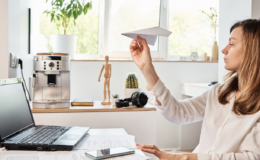We all know meditation for anxiety is a powerful tool to find your inner calm. But what if you don’t want to meditate? And what if you try it and aren’t sure you’re doing it right?
The earliest memory of my anxiety was in fifth grade. I remember it so vividly because in middle school the bus came at 6:22am exactly in the morning.
Each night I would look at my Garfield clock and think, “If I fall asleep now, I’ll get 4 hours of sleep…. If I fall asleep now, I’ll get 3 hours of sleep…”
I didn’t know I had anxiety.
In high school, the anxiety was worse. I couldn’t eat breakfast because I was too nauseous from stress.
By college, there were months when I could barely open my mouth because my jaw was so tight from clenching.
In my twenties I started having panic attacks, I kept getting into codependent relationships driven by the fear of rejection, and my body was a wreck from tension headaches, stomach issues, and I kept getting sick.
I finally figured out that this was all anxiety.
It was starting to make sense why my pursuit of symptom relief for all my pain was not working—I wasn’t getting to the root of the problem.
So I started practicing meditation, even though I didn’t’ really know how.
It helped calm me in the moment… sometimes. And I noticed my anxiety symptoms improved a little bit.
But my anxiety didn’t go away… yet.
Once I understood HOW meditation works, I finally started getting in control over my emotions and finding my inner calm.
How to practice meditation for anxiety
While meditation was kind of helping, I kept thinking I was doing it wrong.
- I thought my mind should be completely quiet – but it wasn’t.
- I thought it should feel peaceful – but it was often a struggle.
- I skipped practicing because I didn’t think I could sit still – which is the point of meditation!
- And I still kept getting anxious and stressed.
Like the nerd I am, I dug into WHY meditation works by understanding mechanically – what is happening when we meditate?
A focused-attention meditation – like mindfulness meditation – takes 3 steps: notice, acknowledge, and redirect.
- When we meditate, we notice when our attention has been taken away from our focal point (like our breath).
- Then we acknowledge this without judgment, maybe even label what we were thinking about like “planning” or “worrying.” Not running from it or denying it, but with acceptance, allowing this to have happened.
- And then we gently release our hold on that thought and redirect our attention back to where we want it—our breath.
The key to breaking the cycle of anxiety is practicing meditation-in-action
Once I started thinking of meditation as practice—like football practice—I began to realize that each 2, 5, or 20-minute session of meditation was really preparing my mind to handle the real-world stressors off of my meditation cushion.
That’s when I realized I had to learn how to “practice” even when I wasn’t meditating. Meditation is more than just focusing on your breath. It is a training exercise for your mind.
This process of noticing, acknowledging, and redirecting teaches us how to:
- Be in the present moment
- Become consciously aware of our thoughts
- Choose curiosity over judgment
- Practice self-compassion and patience
- Let go of control
These are all skills essential to learning how to relate differently to the thoughts that cause our anxiety. These skills give you more control over your emotions by change your relationship with your thoughts, expectations and discomfort.
So, when I texted a friend and she didn’t text back (an old trigger of mine), I was learning how to:
- Notice: “Ah, I’m feeling anxious because I am thinking the reason she hasn’t replied is because she doesn’t like me as much as I like her, and I’m believing that her reply would prove that I am good enough and likable.”
- Acknowledge: “This is an uncomfortable feeling, but I will allow it to be here until it has passed. Even though she hasn’t replied, I choose to love and accept myself.”
- Redirect: “I open to the possibility that her lack of reply could have another explanation—she may be busy or sick or forgot to reply. I can wait or I can message her again. Even if she is angry with me, I can make amends because I am a good person.”
Instead of swirling down the rabbit hole of “what is wrong with me?”, I was learning to recognize these thoughts as just ideas that my brain served up based on a habit I’d cultivated after years of believing I wasn’t good enough.
While this understanding didn’t stop me from having those thoughts, it greatly reduced them, and when it did happen, I could easily get back to calm and in control. Instead of believing them as truth, I was now able to see them for what they are—a defense mechanism to try and keep me safe.
What happened after practicing meditation for anxiety
As a result, my anxiety went down. I started feeling better. I was learning to be kind to myself. Which made me more confident. And that changed the trajectory of my entire life.
It started with learning to meditate-in-action.
Where to go from here:
- Work with me 1:1: For leaders and parents feeling lost trying to grow and heal on their own, ready for a guide on their journey out of anxiety into the happiest, most Zen-Badass version of yourself from the boardroom to the family room.
- 21 Day Meditation-in-Action emotional transformation (now only $37). In as few as 4 minutes a day, learn how to retrain your mind for resilience, peace and focus.
- Free Training – Learn the 4 Shifts to Ease Anxiety and Find Your Inner Zen-Badass: Access the free mini-but-mighty Graceful Resilience® training to learn the skills to become calm, confident and in control over your emotions so your career and relationships thrive.






Leave a Comment